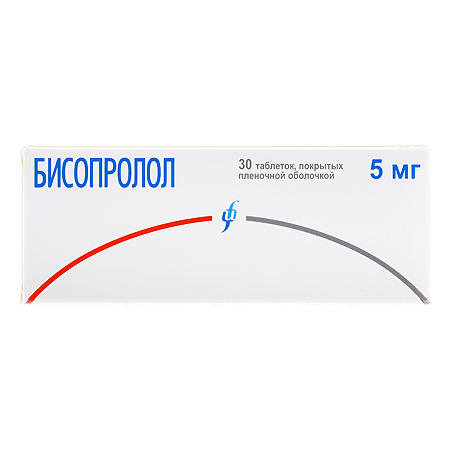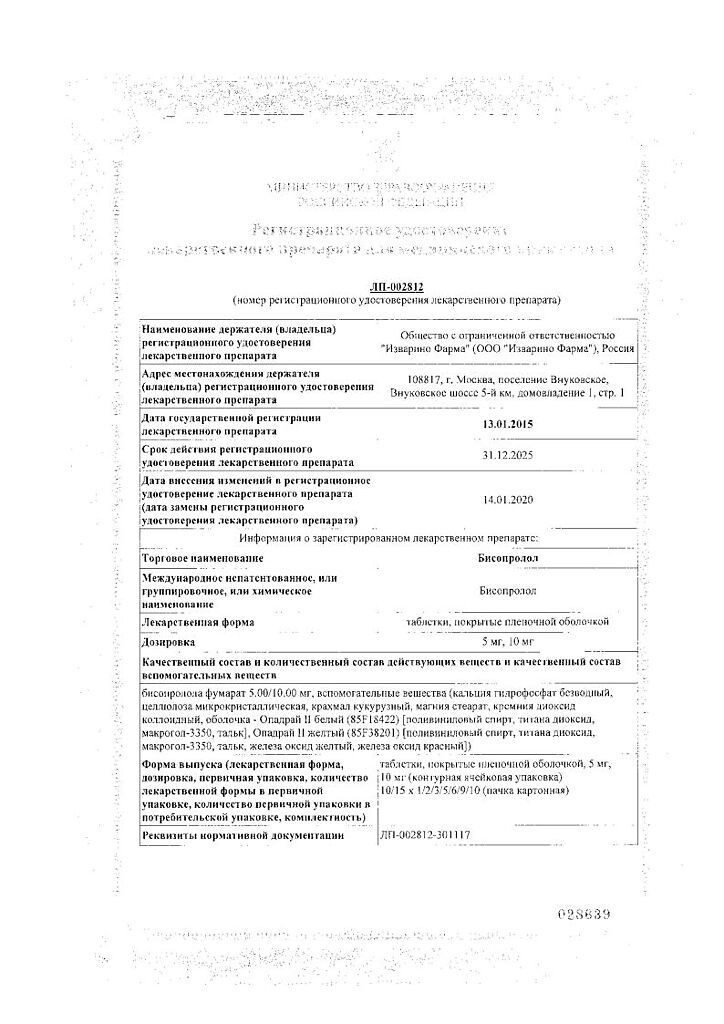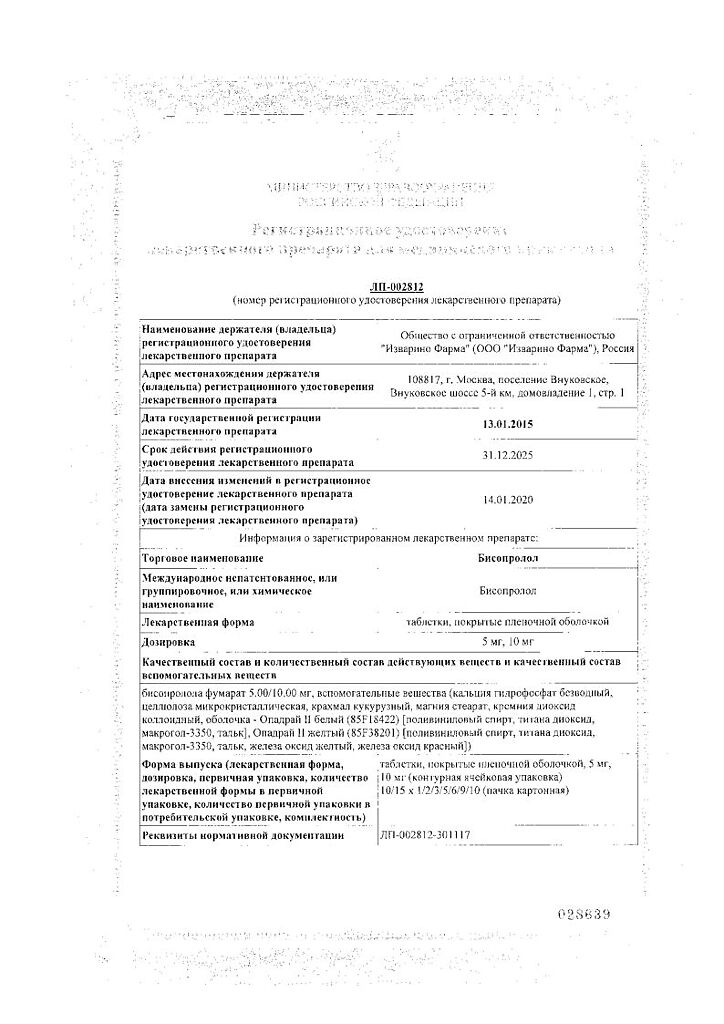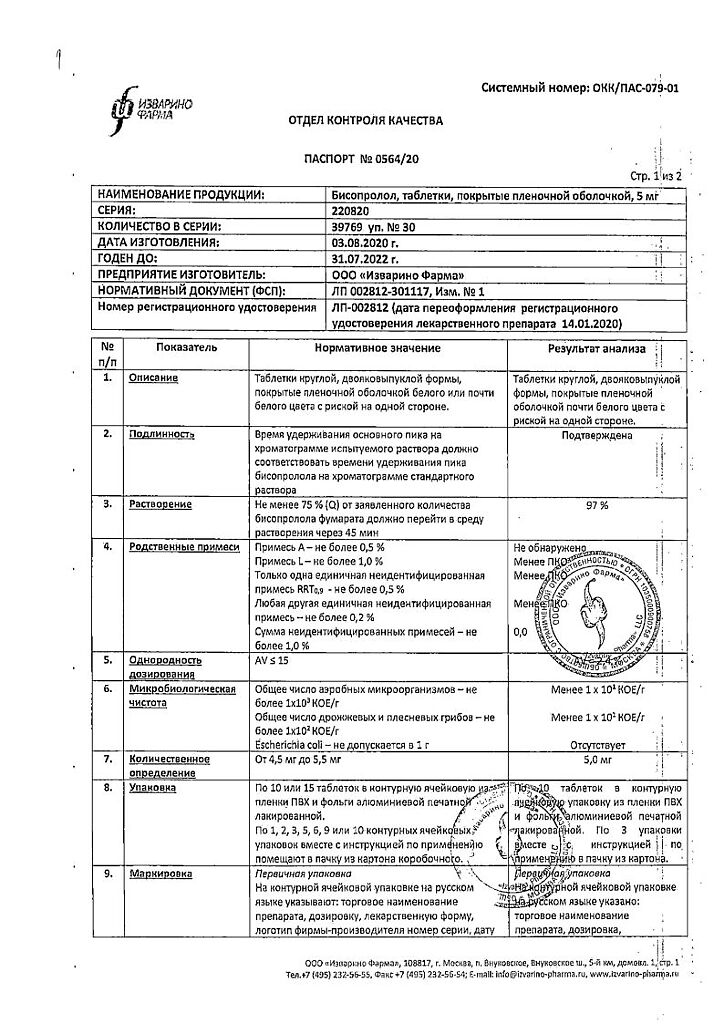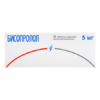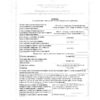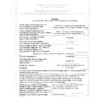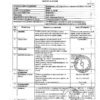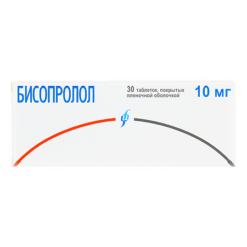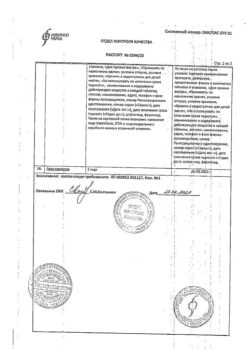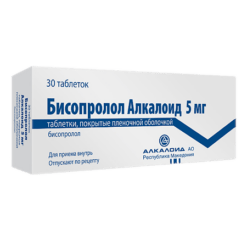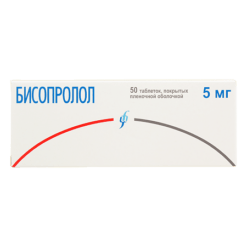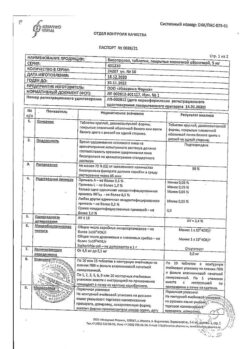No products in the cart.
Bisoprolol, 5 mg 30 pcs.
€4.16 €3.69
Description
A selective beta1-adrenoblocker, without its own sympathomimetic activity, has no membrane stabilizing effect. It reduces plasma renin activity, decreases myocardial oxygen demand, reduces HR (at rest and under load).
It has hypotensive, antiarrhythmic and antianginal action. By blocking in low doses beta1-adrenoreceptors in heart, it decreases catecholamine-stimulated cAMP formation from ATP, decreases intracellular calcium ions flow, produces negative chrono-, dromo-, batmo- and inotropic effects, inhibits myocardial conduction and excitability and decreases AV-conduction.
If the dose is increased above the therapeutic, it has a beta2-adrenoblocking effect.
The HRP at the beginning of drug administration, in the first 24 h, increases (as a result of reciprocal increase of alpha-adrenoreceptor activity and elimination of beta2-adrenoreceptor stimulation) which returns to baseline in 1-3 days, and decreases with prolonged administration.
Hypotensive effect is associated with decreased minute blood volume, sympathetic stimulation of peripheral vessels, decreased activity of renin-angiotensin system (of great importance for patients with initial renin hypersecretion), restoration of sensitivity in response to BP decrease and influence on CNS. For arterial hypertension the effect comes in 2-5 days, stable effect – in 1-2 months.
The antianginal effect is caused by decrease of myocardial oxygen demand as a result of decrease of HR and contractility, prolongation of diastole, improvement of myocardial perfusion. By increasing left ventricular end-diastolic pressure and increasing ventricular muscle fiber stretch may increase oxygen demand, especially in patients with chronic heart failure.
The antiarrhythmic effect is caused by the removal of arrhythmogenic factors (tachycardia, increased activity of the sympathetic nervous system, increased content of CAMF, arterial hypertension), reduction of the rate of spontaneous excitation of sinus and ectopic pacemakers and slowing of AV conduction (mainly in the antegrade and, to a lesser degree, in the retrograde direction through the AV node) and through additional pathways.
In contrast to non-selective beta-adrenoblockers, when administered in medium therapeutic doses, it has less pronounced effect on the organs containing beta2-adrenoreceptors (pancreas, skeletal muscles, smooth muscle of peripheral arteries, bronchi and uterus) and on carbohydrate metabolism, does not cause delay of sodium ions (Na+) in the body; the severity of atherogenic action does not differ from that of propranolol.
Pharmacokinetics
Absorption and distribution
Absorption is 80-90%, absorption is not affected by eating. Cmax in blood plasma is observed after 1-3 hours.
The binding to plasma proteins is about 30%. It passes through the BBB and placental barrier to a small extent, in small amounts is excreted with breast milk.
Metabolism and excretion
50% of the dose is metabolized in the liver with the formation of inactive metabolites.
The T1/2 is 10-12 hours. About 98% is excreted in the urine – 50% unchanged, less than 2% in the bile.
Indications
Indications
– arterial hypertension;
— IHD: prevention of angina attacks.
Pharmacological effect
Pharmacological effect
A selective beta1-blocker, without its own sympathomimetic activity, does not have a membrane-stabilizing effect. Reduces plasma renin activity, reduces myocardial oxygen demand, and reduces heart rate (at rest and during exercise).
It has hypotensive, antiarrhythmic and antianginal effects. By blocking beta1-adrenergic receptors of the heart in low doses, it reduces the formation of cAMP from ATP stimulated by catecholamines, reduces the intracellular current of calcium ions, has a negative chrono-, dromo-, bathmo- and inotropic effect, inhibits the conductivity and excitability of the myocardium, and reduces AV conductivity.
When increasing the dose above the therapeutic one, it has a beta2-adrenergic blocking effect.
OPSS at the beginning of drug use, in the first 24 hours, increases (as a result of a reciprocal increase in the activity of alpha-adrenergic receptors and the elimination of stimulation of beta2-adrenergic receptors), which after 1-3 days returns to the original level, and with long-term administration decreases.
The hypotensive effect is associated with a decrease in minute blood volume, sympathetic stimulation of peripheral vessels, a decrease in the activity of the renin-angiotensin system (of great importance for patients with initial hypersecretion of renin), restoration of sensitivity in response to a decrease in blood pressure and an effect on the central nervous system. In case of arterial hypertension, the effect occurs after 2-5 days, stable effect – after 1-2 months.
The antianginal effect is due to a decrease in myocardial oxygen demand as a result of a decrease in heart rate and decreased contractility, prolongation of diastole, and improved myocardial perfusion. By increasing end-diastolic pressure in the left ventricle and increasing the stretch of ventricular muscle fibers, it can increase oxygen demand, especially in patients with chronic heart failure.
The antiarrhythmic effect is due to the elimination of arrhythmogenic factors (tachycardia, increased activity of the sympathetic nervous system, increased cAMP content, arterial hypertension), a decrease in the rate of spontaneous excitation of sinus and ectopic pacemakers and a slowdown of AV conduction (mainly in the antegrade and, to a lesser extent, in the retrograde directions through the AV node) and along additional pathways.
When used in average therapeutic doses, in contrast to non-selective beta-blockers, it has a less pronounced effect on organs containing beta2-adrenergic receptors (pancreas, skeletal muscles, smooth muscle of peripheral arteries, bronchi and uterus) and on carbohydrate metabolism, does not cause retention of sodium ions (Na+) in the body; the severity of the atherogenic effect does not differ from the effect of propranolol.
Pharmacokinetics
Suction and distribution
Absorption – 80-90%, food intake does not affect absorption. Cmax in blood plasma is observed after 1-3 hours.
Communication with blood plasma proteins is about 30%. Passes through the BBB and the placental barrier to an insignificant extent, and is excreted in breast milk in small quantities.
Metabolism and excretion
50% of the dose is metabolized in the liver to form inactive metabolites.
T1/2 – 10-12 hours. About 98% is excreted in the urine – 50% unchanged, less than 2% – with bile.
Special instructions
Special instructions
Monitoring of patients taking Bisoprolol should include measuring heart rate and blood pressure (at the beginning of treatment – daily, then once every 3-4 months), conducting an ECG, determining blood glucose levels in patients with diabetes (once every 4-5 months). In elderly patients, it is recommended to monitor renal function (once every 4-5 months).
The patient should be taught how to calculate heart rate and instructed about the need for medical consultation if the heart rate is less than 50 beats/min.
Before starting treatment, it is recommended to conduct a study of external respiratory function in patients with a burdened bronchopulmonary history.
In approximately 20% of patients with angina, beta blockers are ineffective. The main reasons are severe coronary atherosclerosis with a low ischemic threshold (heart rate less than 100 beats/min) and increased end-diastolic volume of the left ventricle, disrupting subendocardial blood flow.
In smoking patients, the effectiveness of beta-blockers is lower.
Patients using contact lenses should take into account that during treatment the production of tear fluid may decrease.
When used in patients with pheochromocytoma, there is a risk of developing paradoxical arterial hypertension (if effective alpha-blockade is not previously achieved).
In case of thyrotoxicosis, Bisoprolol can mask certain clinical signs of thyrotoxicosis, for example, tachycardia. Abrupt withdrawal in patients with thyrotoxicosis is contraindicated because it can increase symptoms.
In diabetes mellitus, it can mask tachycardia caused by hypoglycemia. Unlike non-selective beta-blockers, it practically does not enhance insulin-induced hypoglycemia and does not delay the restoration of blood glucose concentrations to normal levels.
When taking clonidine concomitantly, it can be discontinued only a few days after discontinuation of Bisoprolol.
It is possible that the severity of the hypersensitivity reaction may increase and there will be no effect from the usual doses of zpinephrine against the background of a burdened allergy history. If planned surgical treatment is necessary, the drug should be discontinued 48 hours before the start of general anesthesia. If the patient took the drug before surgery, he should select a drug for general anesthesia with minimal negative inotropic effect.
Reciprocal activation of the vagus nerve can be eliminated by intravenous atropine (1-2 mg).
Medicines that reduce the supply of catecholamines (including reserpine) can enhance the effect of beta-blockers, so patients taking such combinations of drugs should be under constant medical supervision to detect a pronounced decrease in blood pressure or bradycardia.
Patients with bronchospastic diseases can be prescribed cardioselective adrenergic blockers in case of intolerance and/or ineffectiveness of other antihypertensive drugs. An overdose is dangerous due to the development of bronchospasm.
If increasing bradycardia (less than 50 beats/min), a pronounced decrease in blood pressure (systolic blood pressure below 100 mm Hg), or AV blockade is detected in elderly patients, it is necessary to reduce the dose or stop treatment.
It is recommended to discontinue therapy if depression develops.
Treatment should not be abruptly interrupted due to the risk of developing severe arrhythmias and myocardial infarction. Cancellation is carried out gradually, reducing the dose over 2 weeks or more (reduce the dose by 25% in 3-4 days). It should be discontinued before testing the content of catecholamines, normetanephrine and vanillinmandelic acid in the blood and urine, and titers of antinuclear antibodies.
Impact on the ability to drive vehicles and operate machinery
During the treatment period, care must be taken when driving vehicles and engaging in other potentially hazardous activities that require increased concentration and speed of psychomotor reactions.
Active ingredient
Active ingredient
Bisoprolol
Composition
Composition
bisoprolol fumarate 5 mg.
Excipients:
croscarmellose sodium (primellose),
povidone (medium molecular weight polyvinylpyrrolidone),
pregelatinized starch (starch 1500),
colloidal silicon dioxide (Aerosil),
talc,
microcrystalline cellulose,
lactose (milk sugar),
magnesium stearate.
Film shell composition:
opadry II (polyvinyl alcohol, partially hydrolyzed, titanium dioxide, talc, macrogol (polyethylene glycol 3350),
iron (II) oxide dye).
Contraindications
Contraindications
— shock (including cardiogenic);
— collapse;
– pulmonary edema;
– acute heart failure;
— chronic heart failure in the stage of decompensation;
– AV block of II and III degrees;
– sinoatrial blockade;
— SSSU;
– severe bradycardia;
– Prinzmetal’s angina;
– cardiomegaly (without signs of heart failure);
– arterial hypotension (systolic blood pressure less than 100 mm Hg, especially with myocardial infarction);
– severe forms of bronchial asthma and a history of chronic obstructive pulmonary disease;
– simultaneous use of MAO inhibitors (with the exception of MAO-B);
– late stages of peripheral circulatory disorders, Raynaud’s disease;
– pheochromocytoma (without simultaneous use of alpha-blockers);
– metabolic acidosis;
– age under 18 years (efficacy and safety have not been established);
– hypersensitivity to the components of the drug and other beta-blockers.
The drug should be prescribed with caution in case of liver failure, chronic renal failure, myasthenia gravis, thyrotoxicosis, diabetes mellitus, first degree AV blockade, depression (including a history), psoriasis, as well as in elderly patients.
Side Effects
Side Effects
From the central nervous system: increased fatigue, weakness, dizziness, headache, sleep disorders, depression, anxiety, confusion or short-term memory loss, hallucinations, asthenia, myasthenia, paresthesia in the extremities (in patients with intermittent claudication and Raynaud’s syndrome), tremor.
From the senses: blurred vision, decreased secretion of tear fluid, dry and sore eyes, conjunctivitis.
From the cardiovascular system: sinus bradycardia, palpitations, myocardial conduction disturbances, AV block (up to the development of complete transverse block and cardiac arrest), arrhythmias, weakening of myocardial contractility, development (worsening) of chronic heart failure (swelling of the ankles, feet, shortness of breath), decreased blood pressure, orthostatic hypotension, manifestation of vasospasm (increased peripheral circulatory disorders, coldness of the lower extremities, Raynaud’s syndrome), chest pain.
From the digestive system: dryness of the oral mucosa, nausea, vomiting, abdominal pain, constipation or diarrhea, liver dysfunction (dark urine, yellowness of the sclera or skin, cholestasis), changes in taste.
From the respiratory system: nasal congestion, difficulty breathing when prescribed in high doses (loss of selectivity) and/or in predisposed patients – laryngo- and bronchospasm.
From the endocrine system: hyperglycemia (in patients with insulin-dependent diabetes mellitus), hypoglycemia (in patients receiving insulin), hypothyroid state.
Allergic reactions: skin itching, rash, urticaria.
Dermatological reactions: increased sweating, skin hyperemia, exanthema, psoriasis-like skin reactions, exacerbation of psoriasis symptoms.
From laboratory parameters: thrombocytopenia (unusual bleeding and hemorrhage), agranulocytosis, leukopenia, changes in the activity of liver enzymes (increased ALT, AST), bilirubin levels, triglycerides.
Effect on the fetus: intrauterine growth retardation, hypoglycemia, bradycardia.
Other: back pain, arthralgia, weakened libido, decreased potency, withdrawal syndrome (increased angina attacks, increased blood pressure).
Overdose
Overdose
Symptoms: arrhythmia, ventricular extrasystole, severe bradycardia, AV block, marked decrease in blood pressure, chronic heart failure, cyanosis of fingernails or palms, difficulty breathing, bronchospasm, dizziness, fainting, convulsions.
Treatment: gastric lavage and administration of adsorbents; symptomatic therapy: in case of developed AV block – intravenous administration of 1-2 mg of atropine, epinephrine or installation of a temporary pacemaker; for ventricular extrasystole – lidocaine (class IA drugs are not used); when blood pressure decreases, the patient should be in the Trendelenburg position; if there are no signs of pulmonary edema – intravenous plasma-substituting solutions, if ineffective – administration of epinephrine, dopamine, dobutamine (to maintain chronotropic and inotropic effects and eliminate a pronounced decrease in blood pressure); for heart failure – cardiac glycosides, diuretics, glucagon; for convulsions – intravenous diazepam; for bronchospasm, beta-agonists by inhalation.
Allergens used for immunotherapy or allergen extracts for skin testing increase the risk of severe systemic allergic reactions or anaphylaxis in patients receiving bisoprolol.
Iodine-containing radiopaque drugs for intravenous administration increase the risk of developing anaphylactic reactions.
Phenytoin, when administered intravenously, and drugs for inhalation general anesthesia (hydrocarbon derivatives) increase the severity of the cardiodepressive effect and the likelihood of a decrease in blood pressure.
Changes the effectiveness of insulin and oral hypoglycemic drugs, masks the symptoms of developing hypoglycemia (tachycardia, increased blood pressure).
Reduces the clearance of lidocaine and xanthines (except diphylline) and increases their concentration in plasma, especially in patients with initially increased clearance of theophylline under the influence of smoking.
The hypotensive effect is weakened by NSAIDs (Na+ retention and blockade of prostaglandin synthesis by the kidneys), corticosteroids and estrogens (Na+ ion retention).
Cardiac glycosides, methyldopa, reserpine and guanfacine, slow calcium channel blockers (verapamil, diltiazem), amiodorone and other antiarrhythmic drugs increase the risk of developing or worsening bradycardia, AV block, cardiac arrest and heart failure.
Nifedipine can lead to a significant decrease in blood pressure.
Diuretics, clonidine, sympatholytics, hydralazine and other antihypertensive drugs can lead to an excessive decrease in blood pressure.
Prolongs the effect of non-depolarizing muscle relaxants and the anticoagulant effect of coumarins.
Tri- and tetracyclic antidepressants, antipsychotic drugs (neuroleptics), ethanol, sedatives and hypnotics increase CNS depression.
Concomitant use with MAO inhibitors is not recommended due to a significant increase in the hypotensive effect; the break in treatment between taking MAO inhibitors and bisoprolol should be at least 14 days.
Non-hydrogenated ergot alkaloids increase the risk of developing peripheral circulatory disorders.
Ergotamine increases the risk of developing peripheral circulatory disorders; sulfasalazine increases the concentration of bisoprolol in plasma; Rifampin shortens the half-life.
Manufacturer
Manufacturer
Izvarino Pharma, Russia
Additional information
| Manufacturer | Izvarino Pharma, Russia |
|---|---|
| Medication form | pills |
| Brand | Izvarino Pharma |
Other forms…
Related products
Buy Bisoprolol, 5 mg 30 pcs. with delivery to USA, UK, Europe and over 120 other countries.

